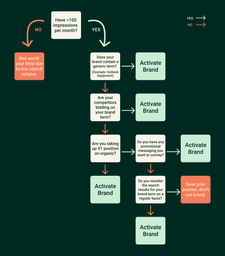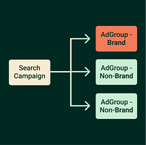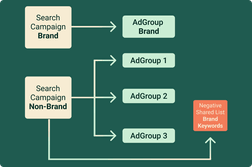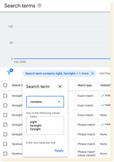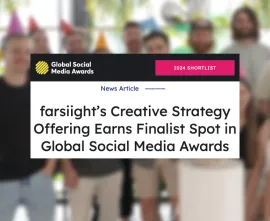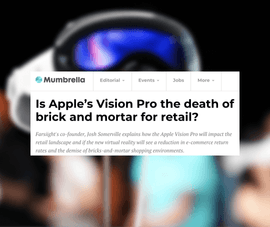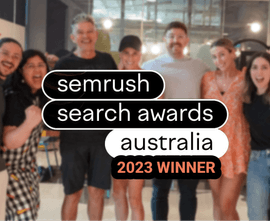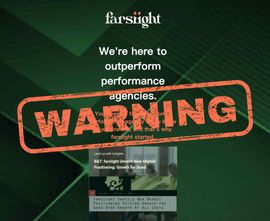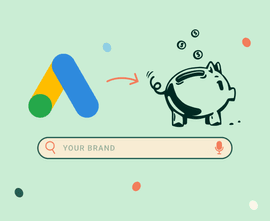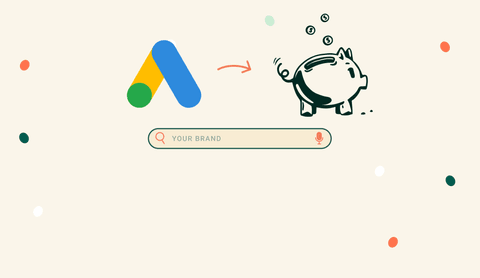
Google Ads Branded Traffic Guide to Improving Profitability
Are you maximising brand efficiency, or is your brand leading to significant expenses? The debate over investing in branded traffic on Google Ads persists, and the same questions posed thirteen years ago still linger.
Who is this guide for? Advertisers who either;
- Have a minimum of 500 monthly searches for your brand term
- Don’t have a considered branded campaign strategy
- Are using an automated bidding strategy on a brand campaign
- Letting Performance Max campaigns serve for branded searches
Introduction
Are You Serving Brand Efficiently, Or Is Brand Serving You Big Bills?
Deciding whether to invest in branded traffic on Google Ads is an age-old debate, and the same questions that were being asked of me thirteen years ago remain the same:
- Should I bother paying for my own branded traffic on Google Ads?
- Am I getting any incremental leads/revenue from running brand?
- I already rank organically, so why throw in an ad as well
These are all valid questions to be asked, and likely why you are here today.
Deciding whether to activate branded traffic on Google Ads depends on each client’s unique situation and does not live in a static environment. Things change rapidly and therefore deciding whether to run brand needs regular evaluation. Some of these are:
- Are competitors consistently bidding on their brand?
- Is their company name generic (e.g., – aus solar co)?
- How strong is their organic presence?
- What is the overall search volume for their brand-related keywords?
- Are there any ongoing marketing campaigns or promotions or product drops that can benefit from the flexibility of ad messaging?
The issue many advertisers run into with brand isn’t whether to use it or not, but how it fits into their overall campaign strategy. More often than not, they end up overpaying for brand in a big way. I’ll showcase what that looks like shortly.
Decision Tree
Should I run brand?
Decision Tree
Should I Bother Investing in Branded Traffic on Google Ads?
Let me break this down for you…
Have <100 impressions per month
This one is simple. Typically Google will only serve keywords that have at least 100 impressions. If they don’t, you’ll see a “low search volume” error message next to the keyword in Google Ads. Most of the time, this keyword will not be delivered and therefore it’s not worth your time or energy.
Also, unless you have at least 500 impressions, the strategies outlined in this document won’t save you that much money.
Does Your Brand Name Contain A Generic Term
Consider our client “Outback Equipment” as an example. A generic brand name poses the risk of competitors serving ads for your name unintentionally.
This could happen if they have a term in their non-brand campaigns like “outdoor equipment,” and due to Google Ads’ broad match system, they end up serving ads for “Outback Equipment.”
So, while you might think they’re running ads specifically for your brand term, there’s a good chance it’s happening indirectly through their non-brand search, dynamic search ads, or Performance Max campaigns.
Are Competitors Bidding on Your Brand Term?
You’ll know if competitors are directly targeting your brand term if they start getting “creative” with the messaging. Take SponsoredLinx for example who are bidding on our brand term…
If you are looking for better from your copywriting then perhaps switching to SponsoredLinx isn’t the best choice.
Are You Taking Up #1 Organic Position?
Typically, if you’re holding the #1 organic position and don’t plan on going to market with any promotional messaging, you may decide not to run branded campaigns.
However, there are situations where it might be advantageous to enhance visibility with an ad, especially if competitors are also appearing for your brand term organically.
As an example, this scenario can happen if they write competitor comparison pages on their website.
Do you have any promotional messaging to convey?
Running branded campaigns offers the flexibility to tailor your messaging according to your present needs.
Whether you’re running a promotion or featuring a new product drop, branded campaigns allow you to deliver targeted messages that are not easily achieved with organic ads.
If you decide to run promotional messaging, you may decide to temporarily activate a branded strategy.
Do You Keep Track of Brand Searches?
It only takes one competitor with a compelling offer to initiate bidding on your brand.
Suddenly, your revenue takes a hit, and you find yourself scratching your head.
If you’re not consistently keeping tabs on your competitors, I recommend initiating a brand campaign as a proactive measure for future protection, utilising the cost-saving strategies outlined below.
Three Commonly Used Campaign Strategies To Avoid
It’s important to realise that brand searches, due to the very high intent, usually convert at a much higher rate than non-brand traffic. Therefore, it needs to be treated differently.
Also, any competitor that is directly or indirectly targeting your brand usually suffers from very low-quality scores and has to pay significantly more than you to rank for your brand.
Combining Brand & Non-Brand
We recommend avoiding combining both brand and non-brand into a single campaign. This practice complicates data analysis for each segment and prevents gaining insights at the campaign level with ease.
You may think the campaign is crushing it, and when you scale the ROAS tanks. That’s because you can’t scale brand without increasing your investment in other channels and the proportion of spend on brand relative to non-brand diminishes as you scale.
Summarising the negatives:
✗ Reporting on performance in each segment
✗ Limited flexibility in adjusting campaign settings and bidding strategies
✗ Risk of poor decisions based on consolidated performance metrics
Automated Bidding
Using automated bidding strategies such as tROAS or tCPA for your branded keywords will lead to overpaying significantly—up to 20 times higher CPCs than necessary.
This scenario, while surprising, is not uncommon in my experience.
When opting for automated bidding, Google charges a higher cost per click, leveraging its machine-learning capabilities to make real-time decisions based on current intent.
Typically, the benefit of automated bidding kicks in with an increased conversion rate that offsets the rise in CPC. However, when it comes to branded keywords, the expected uptick in conversion rate often doesn’t materialise, given how high the intent and conversion rate already is.
Summarising the negatives:
✗ Overpaying for CPCs
Performance Max/DSA
Allowing your brand searches to run through Performance Max campaigns mirrors the issues discussed with using automated bidding.
Additionally, although PMax is providing more insights than ever it’s still a black box making it challenging to discern the performance of non-brand vs. brand.
We recommend adding a brand exclusion for your brand term in Performance Max. You may be wondering “Well how will I appear in Google Shopping for brand”. More on that shortly.
farsiights Best Practices
Our best practices are designed to lower your investment in brand (while preserving impression share) to free up the budget to drive new customer acquisition using non-branded strategies.
The overarching goal is to protect your brand and increase the incremental revenue coming into the business.
Segmented Brand Campaigns
Direct branded keywords into dedicated campaigns.
We recommend adding a shared negative keyword list to all non-brand campaigns to ensure they stop serving all permutations of your brand. Shared negative lists can be found by going to tools and settings > negative keyword lists.
If your existing campaigns have been serving brand terms, the easiest way to collate this list is by going into your search terms list, clicking on the date selector and selecting “all time”. Then, create a filter by selecting “search terms” and type in various ways in which you think your brand name is being searched.
Take farsiight for example:
Then export the list to Google Sheets, remove duplicates and add the list to your shared negative keyword list as phrase match negatives.
Protip – ensure you add these terms to your Dynamic Search Ad campaigns too, as DSA will always serve for brand without negatives.
Also, I said campaign(s) at the start as there are instances where you may set up multiple branded campaigns for businesses with significant search volume.
Take Kogan for example:
Brand – Exact: Exclusively targets only [kogan] as exact match with negative keywords of their product categories like TV, dishwashers, electronics, etc
Brand – Categories: Includes kogan + category like kogan TV, kogan washing machine, etc, with a exact match negative keyword [kogan]
Brand – OEM: Pretty sure Kogan’s OEM products are called Kogan, but let’s say they aren’t for this example. You’d list their brand names in this campaign.
The rationale is that CPCs in brand exact are likely going to be much lower than brand categories as there are no generic terms that competitors are indirectly bidding on.
A big corporation like Kogan with deep pockets may decide to use manual bidding on their brand exact campaign, but automated bidding on brand categories to remain hyper-competitive.
Summarising the positives:
✔ Simplified reporting on brand vs. non-brand
✔ Flexibility with automated bidding strategies
✔ Make smarter scaling decisions (you can be confident in your non-brand performance & ROAS target as it’s not propped up by brand)
Manual Bidding
Run branded search campaigns on manual bidding, not automated bidding (most of the time).
Though it may seem old school (because, well, it is) this approach ensures you avoid overpaying.
Deciding the ideal CPC limit to set depends on your circumstances and relates to whether your brand term is generic. If it is, setting a more aggressive CPC limit may be necessary to maintain your search impression share.
And that’s the balancing act you need to play when you switch your branded campaign to manual bidding. The aim is to maintain a high search impression share, while reducing CPCs.
Let’s say you switch from automated bidding to manual bidding and set the CPC limit to $1.01 and your impression share doesn’t fall.
The fun game begins with how low can you bring it down before you start to notice your impression share drop. Every 3-4 days, reduce your CPC by 15-20% and review. If no dip in impression share, go again.
To illustrate the effectiveness of making the switch to manual bidding, let’s examine a recent client of ours:
The results before and after:
- 93% decrease in CPC from $0.81 to $0.05
- 10% decrease in impression share (SIS)*
- 67% increase in clicks
*Note – this client has a limited paid budget. Our primary goal was to heavily reduce branded spend, re-allocating the budget to non-brand activity. We were primarily safeguarding brand using standard shopping.
We were prepared to take a slight hit on SIS on branded search as co-current to switching bidding strategy, we overhauled their ads and ad extensions which lifted CTR by ~30%, so we ended up generating 67% more clicks while spending 90% less despite a slight drop in SIS.
Here is a more extreme example of a business we recently audited with a significant monthly search volume (14k+).
Search brand alone accounted for ~23% of their total budget in the past 30 days. They were running branded keywords through PMax, so if you assumed an equal amount of spend in PMax on brand, they are spending nearly half of their Google Ads budget just protecting brand – that’s huge!
The question begs, is the $20k spent protecting brand yielding incremental revenue, or could that budget be more effectively reinvested in reaching new prospective customers unfamiliar with the brand?
For businesses spending this much on brand, the transition from automated bidding to manual requires a considered approach. Our recommendation is to create an experiment campaign set to manual bidding. By experimenting with manual bidding first, you mitigate the risk that comes with making a hard switch for a brand that’s heavily reliant on branded traffic on Google Ads.
Summarising the positives:
✔ Lower CPCs
✔ Re-invest in new customer acquisition campaigns
Standard Shopping Campaigns
If you’ve been running Google Ads campaigns for several years then it’s time to dust off your old standard shopping campaigns.
We have started using Standard Shopping to capture branded searches and leaving Performance Max to non-brand.
This approach allows for reporting on brand and non-brand performance and the flexibility to implement manual bidding on brand terms.
Here’s how you set it up:
- Setup brand exclusions on PMax for your brand term
- Setup a standard shopping campaign
- Review your search terms for the lifetime of your Google Ads account, filtering out all branded traffic on Google Ads and removing duplicates.
- Add this list as a shared negative keyword list to your standard shopping campaign.
Initially, you may notice non-brand terms slipping into your standard shopping campaign but it should be few and far between – just make sure you’re regularly adding these in as negatives. It may take a few weeks to clean up the search terms but it’s worth it in the long run.
Due to the higher bids, PMax will likely pick up on all non-brand searches leaving your standard shopping campaign to pick up cheap branded traffic on Google Ads.
Summarising the positives:
✔ Lower CPCs on brand
✔ Brand vs. non-brand reporting
✔ Increased confidence when scaling PMax
Conclusion
I’m sure by now you’ll see that deciding whether to run branded campaigns and how to approach branded traffic on Google Ads requires careful consideration.
In a nutshell, success hinges on strategic segmentation and being dynamic – things change fast!
Ensure your strategy aligns with the intricacies of your brand, the competitive environment and the ever-evolving changes Google Ads like to make on us.
Truly, this guide will probably be rendered useless in 6-12 months.

Josh Somerville
Josh is the co-founder of farsiight and has spent the past 12 years scaling PPC campaigns.
Like what you read?
Learn more about digital, creative and platform strategies below.
